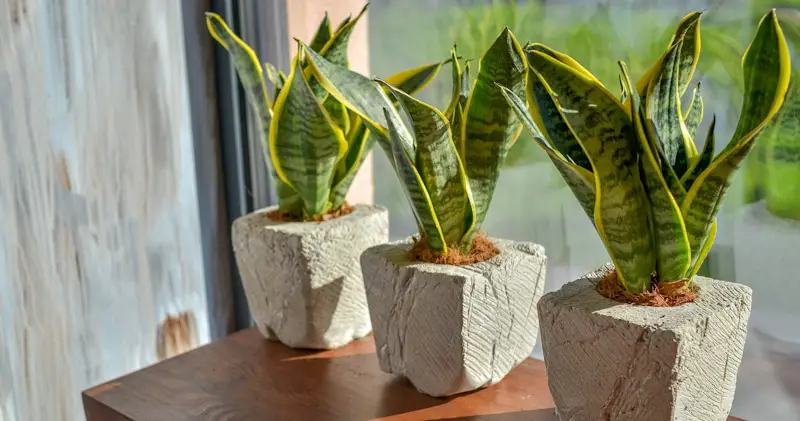Snake Plants are the easiest ones to plant as well as care for. They do not need much water since they have leaves as succulents do. So, you can probably go three or four days without watering them.
Although, they might not survive in poor conditions. The soil might not absorb water, and consequently, your plant will not be getting the nutrients it needs to survive. So, you might end up killing a nearly impossible-to-kill plant if you do not repot when it is time.
But when do you repot? What is the best way to repot a snake plant? If you are confused, then this article is for you. We will discuss everything you need to know below, so keep reading.

How To Repot A Snake Plant?
Repotting a plant is pretty easy, actually, if you know the proper steps. Lucky for you, the following guide contains all the information you need to complete the task.
1. Prepare The Soil
Did you know that the soil for a plant grown in a pot differs from that in the garden? Garden soil is highly dense for contains, and it also compacts quickly. Hence, it holds too much water and does not drain well. Furthermore, it can contain pests and diseases that can harm your plant. Some soils even have weed seeds, which suck up all the nutrients and water.
Hence, you must purchase a houseplant potting mix or make your own. If you choose the latter, you must tailor the soil according to your plant’s needs.
Snake plant leaves retain water. Furthermore, they are susceptible to root rots. Therefore, when making soil for snake plants, ensure it is well-draining and coarse. To make soil, you need a high-quality potting mix and river sand. Mix both in a 1:1 ratio, and you are good to go!
2. Remove The Plant Carefully
You should probably stop watering the plant for some time before you start this process. It would make the removal much smoother and more manageable.
To remove the plant, squeeze the sides of the pot carefully so that all of the soil releases from the sides and slowly take the plant out. If the soil quality looks poor or you see bacteria or fungi, wash the roots with water.
3. Cut Off The Pups
After cleaning the roots thoroughly, you will start seeing pups and their rhizomes. If there are too many pups, you should cut them off with a sharp knife and plant them in a different pot. Contrarily, if you only see one or two pups, do not remove them. Instead, let them grow with the plant.
However, many experts suggest removing all pups is better because, ultimately, they would grow into a plant and cause overcrowding in the pot.
4. Fill The Pot
Finally, prepare the pot. You need to fill one-third of the pot with the soil mixture. Cover the drainage holes at the bottom if they are too large. You can use pebble to do so. Also, do not compact the soil at this stage. The soil needs to be airy and light.
5. Replant
Place the plant gently into the center of the pot. Keep the plant steady as you fill the soil around it till below the top. While pouring the soil, make sure that you keep it a few inches below the top. The crown of the plant needs to be clear of any soil. Otherwise, it would rot in the moist soil.
After filling the pot, press the top layer of the soil down with your hand to secure the plant in place. Lastly, water and place it in direct sunlight.
Signs Your Snake Plant Needs To Be Repotted
Knowing how to repot isn’t going to be enough. You need to know when to do it as well so your small green plant can survive for a longer time. Besides, if you repot it when it does not really need it, it would cause unnecessary stress. Here are some signs indicating whether your plants need a new home or not.

1. The Water Drains Immediately
One of the quickest ways to detect whether your plants need to be shifted is by pouring water into the pot. Does the soil seem dry? Does the water drain right to the bottom of the pot? If yes, you need to change the pot.
Snake plants typically do not need an ample amount of water. They thrive on neglect which also makes them the perfect houseplants. So, if they do not take in the water, it is a problem, and your plant might die soon.
There are several reasons why the soil does not absorb the liquid. First, it can happen because of poor-quality soil. When the roots grow and you frequently water the plant, the soil loses its structure and deteriorates. On the other hand, if the roots have overgrown, there is not enough soil in the pot. And the soil only absorbs some of the water while it drains the rest.
No matter the reason, if your snake plant has not been accepting water and instead drains it to the bottom, you need to change the pot.
2. Drainage Holes Have Roots
This is a sign that is common among all types of houseplants. If you witness roots growing from the drainage holes, the roots have nowhere else to expand. So, change it immediately.
If you do not change it, the plant will struggle to survive. This is because it would not take up water or nutrients in the soil. Overcrowding can also stunt the growth of plants, and in the end, you will have a withering plant, and no one wants that.
3. The Pot Has Cracks
Many experts say that snake plants can survive in overcrowding situations. However, it might not survive in a cracked pot. Since the surface will be exposed to air, the moisture will seep out of the pot much quicker. Furthermore, the roots will start growing through the roots. So, before it gets messy and you have to say goodbye to your houseplant, change as soon as you see a distorted or cracked pot.
4. The Plants Falls Over Repeatedly
Snake plants have tall, thick leaves and vigorous rhizomes, which can cause the plant to topple over. This, along with dissolving soil, can cause the pot to topple repeatedly. The disruption is not suitable for the plant, but it may indicate that you should allow your snake plant a little more room to flourish.
Your plant should never be more than double the size of the pot it is in. When repotting, select a pot that is one or two sizes larger. A pot with too much excess space can retain too much water, which will cause root rot. These sluggish growths won’t require repotting for a few years in a little larger container.
5. Several Pups
Pups are new shoots present at the base of the plant. The tiny pups connect with a rhizome and emerge into the soil closest to the plant. While a simple singular pup might not cause a problem, several can be dangerous for the plant.
If you notice too many new shootings, remove them with their roots from the parent plant. You need to use a sharp knife to do this because otherwise, the roots can be botched. Once you harvest these, you can repot them into a brand-new pot.
Final Words
Snake Plants are easy to repot. You just need to release the soil easily and clean up the roots before replanting it. However, you need to watch out for pups. Furthermore, do not use garden soil for your houseplant; it is too compact and might wither your plant.
Victoria is the owner and main author of hobby plants. She loves spending her free time in her garden planting and taking care of her plants. Victoria hopes you enjoy the content here!
![How to Repot a Fiddle Leaf Fig [COMPLETE GUIDE] How to Repot a Fiddle Leaf Fig [COMPLETE GUIDE]](https://www.hobbyplants.com/wp-content/uploads/2022/06/how-to-repot-a-fiddle-leaf-fig-300x158.jpg)
![How To Propagate Snake Plant? [BEGINNER'S GUIDE] How To Propagate Snake Plant? [BEGINNER'S GUIDE]](https://www.hobbyplants.com/wp-content/uploads/2022/08/how-to-propagate-snake-plant-300x158.jpg)
![Can Snake Plants Live Outside? [COMPLETE CARE GUIDE] Can Snake Plants Live Outside? [COMPLETE CARE GUIDE]](https://www.hobbyplants.com/wp-content/uploads/2022/08/can-snake-plants-live-outside-300x158.jpg)

![How Often Do You Water A Snake Plant? [FIND OUT HERE] How Often Do You Water A Snake Plant? [FIND OUT HERE]](https://www.hobbyplants.com/wp-content/uploads/2022/07/how-often-do-you-water-a-snake-plant-1-300x158.jpg)
![Mother Of Thousands Plant [Complete Plant Care Guide] Mother Of Thousands Plant [Complete Plant Care Guide]](https://www.hobbyplants.com/wp-content/uploads/2022/07/mother-of-thousands-plant-300x158.jpg)
![Bleeding Heart Plant Varieties [COMPLETE BEGINNER'S GUIDE] Bleeding Heart Plant Varieties [COMPLETE BEGINNER'S GUIDE]](https://www.hobbyplants.com/wp-content/uploads/2022/07/bleeding-heart-plant-300x158.jpg)
![Majesty Palm Plant Care: [Complete Beginner's Guide] Majesty Palm Plant Care: [Complete Beginner's Guide]](https://www.hobbyplants.com/wp-content/uploads/2022/08/majesty-palm-care-300x158.jpg)
![Exotic Angel Plant Care: [Complete Beginner's Guide] Exotic Angel Plant Care: [Complete Beginner's Guide]](https://www.hobbyplants.com/wp-content/uploads/2022/08/exotic-angel-plant-care-300x158.jpg)
![Snow White Waffle Plant: [Complete Care Guide] Snow White Waffle Plant: [Complete Care Guide]](https://www.hobbyplants.com/wp-content/uploads/2022/08/snow-white-waffle-plant-300x158.jpg)
![Waffle Plant Care: [Complete Beginner's Guide] Waffle Plant Care: [Complete Beginner's Guide]](https://www.hobbyplants.com/wp-content/uploads/2022/08/waffle-plant-300x158.jpg)
![Bird Of Paradise Plant Care: [Complete Beginner's Guide] Bird Of Paradise Plant Care: [Complete Beginner's Guide]](https://www.hobbyplants.com/wp-content/uploads/2022/08/bird-of-paradise-plant-300x158.jpg)